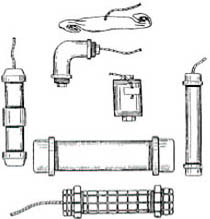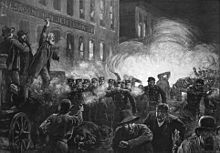Pipe bomb: Difference between revisions
m Reverted edits by 65.60.231.167 (talk) to last version by ClueBot |
Palladmial (talk | contribs) removed the pop culture section |
||
| Line 64: | Line 64: | ||
|date=24 Aug 2006 |
|date=24 Aug 2006 |
||
}}</ref> |
}}</ref> |
||
==Popular Culture== |
|||
* In the cult classic ''[[Deep Blue Sea]]'', survivors of a shark attack attempt to kill the remaining shark by rigging a pipe bomb from a harpoon gun cartridge and igniting it with a battery. |
|||
* A pipe bomb is one of the defensive weapons used in the video game ''[[Left 4 Dead]]''. |
|||
==References== |
==References== |
||
Revision as of 20:15, 7 January 2010

A pipe bomb is an improvised explosive device, a tightly sealed section of pipe filled with an explosive material. The containment provided by the pipe means that simple low explosives can be used to produce a relatively large explosion, and the fragmentation of the pipe itself creates potentially lethal shrapnel.
Premature detonation is a hazard of attempting to construct any homemade bomb, and the materials and methods used with pipe bombs make unintentional detonation incidents common, usually resulting in serious injury or death to the assembler.
In many countries the manufacture or possession of a pipe bomb is a serious crime, regardless of its intended use.
Design

The bomb is usually a short section of steel water pipe containing the explosive mixture and closed at both ends with steel or brass caps. A fuse is inserted into the pipe with a lead running out through a hole in the side or capped end of the pipe. The fuse can be electric with wires leading to a timer and battery or can be a common fuse such as used in most consumer fireworks. All of the components are easily obtainable.
Generally high explosives such as TNT are not used, because these and the detonators they require are difficult to obtain. Such explosives also do not require the containment of a pipe bomb. Instead, any sort of explosive mixture the builder can find or make is used.
Some of the explosive mixtures used, such as black powder, match heads or chlorate mixtures are very prone to ignition by the friction and static electricity generated when packing the material inside the tube or attaching the end caps - accounting for many injuries or deaths amongst builders. If sharp objects, such as nails or broken glass, are added inside the bomb in an attempt to increase the amount of injury, these also add to the risk of premature ignition.
The addition of loosely fixed shrapnel material outside of the bomb can increase the danger of the explosion cheaply and easily. The Unabomber used this method by taping carpentry nails to the outside of his devices. Other variations include using scrap metal or ball bearings.
Devices made from plastic pipe, such as PVC, or thick walled cardboard tube would not be normally considered as "pipe bombs".
Uses
Pipe bombs are often used by criminals, as well as paramilitaries and illegal acting militias. They also have a long tradition of recreational use for amusement or mischief with no intention to cause injury to anyone - but the dangers of premature ignition, and the inherent danger of shrapnel mean that when used in such a manner they are much more dangerous than alternatives such as dry ice bombs or spud guns.
Notable incidents

- On 04 May 1886, a gas-pipe bomb was thrown during a rally at Haymarket Square in Chicago, Illinois.[2] The gas-pipe bomb reached a police line and exploded, killing policeman Mathias J. Degan.[2] The thrown bomb was made from gas-pipe filled with dynamite and capped at both ends with wooden blocks.[2] Old nails were secured tightly by wire around the gas-pipe, which had a hole that received a fuse with a cap.[2] The event became known as the infamous Haymarket riots.
- On 20 October 1930, William Kogut, an inmate on San Quentin's death row, tore up ordinary decks of playing cards and used them to assemble a pipe bomb, which he used to take his own life.[3]
- On 27 July 1996 Eric Rudolph set up a pipe bomb which killed two people and injured 111 more in the Centennial Olympic Park bombing during the 1996 Summer Olympics in Atlanta, Georgia.[4]
- On 20 April 1999 Eric Harris and Dylan Klebold used pipe bombs during the Columbine High School massacre. They threw them around through the course of their school massacre.[5]
- On 11 November 2001 an Ulster Defence Association (UDA) member was killed in Tigers Bay, Belfast, Northern Ireland when the pipe-bomb which he was preparing to use against a neighboring Catholic district exploded prematurely.[6][7]
- On 03 January 2002 a UDA member was killed in Coleraine, County Londonderry, Northern Ireland when the pipe bomb he was handling exploded prematurely during a Loyalist attack on a Catholic district.[8][9]
- On 23 May 2005 the Israel Defense Forces foiled a Palestinian pipe bomb attack at an army roadblock. The 14-year old Palestinian boy was carrying two pipe bombs on his belt.[10]
- Pipe bomb attacks were common during periods of heightened tension in Northern Ireland. On the night of 07 August 2005, two pipe bomb attacks targeted Catholics in the village of Cloughmills of North Antrim in Northern Ireland. The following day, Sinn Féin Councillor Daithí McKay accused loyalist paramilitaries of being behind the attacks.[11]
- On 10 August 2006, four pipe bombs were found in and around the city of Salem, Oregon, and some suspected a serial pipe bomber was at fault. First, a bomb was found attached to a car in the parking garage of Salem Hospital. Then one was located in the parking lot of a 'Roth's IGA' grocery store. Another was found attached to a car in a parking lot in Dallas, Oregon, and another found alongside a Salem roadway. The Salem Police Bomb Squad detonated the bomb outside the 'Roth's' and rendered the rest of the devices safe. The known victims were all residents of south Salem, and a suspect is facing trial.[12][13]
- On 12 September 2006, after an attack by militants on the U.S. Embassy in Damascus, Syria, a van was recovered, full of conventional pipe bombs strapped to small common household Liquefied Petroleum Gas canisters. The attackers appeared to have failed to detonate the bombs; however another smaller vehicle did explode outside the embassy during the late morning surprise attack. [14] [15]
- On August 24, 2009, a former student was arrested after detonating two pipe bombs on the Hillsdale High School campus in San Mateo, California.[16]
References
- ^ "Act II: Let Your Tragedy Be Enacted Here, Moment of Truth". The Dramas of Haymarket. Chicago Historical Society. 2000. Retrieved 2008-01-19.
The details are factually incorrect, because by all accounts Fielden ended his speech before the bomb was thrown, and because the riot did not begin until after the explosion. In [this] depiction, the speech, the explosion, and the riot all take place at once.
- ^ a b c d Lawson, John Davison (1919). American State Trials: A Collection of the Important and Interesting Criminal Trials which Have Taken Place in the United States from the Beginning of Our Government to the Present Day. Thomas Law Books. p. 64.
{{cite book}}: Unknown parameter|coauthors=ignored (|author=suggested) (help) - ^ "Urban Legends Reference Pages: Death by Playing Cards". Snopes.com. 19 Jan 2007.
- ^ "Rudolph reveals motives". CNN.com. 19 Apr 2005.
- ^ "Columbine Massacre". About.com. 24 Aug 2006.
- ^ http://cain.ulst.ac.uk/sutton/chron/2001.html
- ^ http://news.bbc.co.uk/2/hi/uk_news/northern_ireland/1652886.stm
- ^ http://findarticles.com/p/articles/mi_qn4158/is_20020105/ai_n9670628
- ^ http://cain.ulst.ac.uk/issues/violence/deaths2002draft.htm
- ^ "Palestinian boy caught with bombs". Ynetnews. 23 May 2005.
- ^ "Pipe Bomb attacks on North Antrim Catholics". Sinn Féin's Peace Process Special. 08 Aug 2005.
{{cite news}}: Check date values in:|date=(help) - ^ "Pipe Bombs Found in The Salem Area". Salem-News.com. 13 Aug 2006.
- ^ "Salem Pipe Bomb Suspect Back in Court Tuesday". Salem-News.com. 13 Feb 2007.
- ^ http://edition.cnn.com/2006/WORLD/meast/09/12/syria.embassy/index.html
- ^ http://news.bbc.co.uk/2/hi/in_pictures/5337866.stm
- ^ "'Grave Damage' Averted at Hillsdale High School". KCBS. 24 Aug 2006.
- US5,386,758–Apparatus and method for disarming pipe bombs
